Financial Decision Making Report: Analyzing SKANSKA PLC Performance
VerifiedAdded on 2022/12/09
|14
|3758
|111
Report
AI Summary
This report provides a detailed analysis of financial decision-making at SKANSKA PLC, a civil building firm. The introduction emphasizes the importance of efficient financial decision-making and its impact on organizational success. Task 1 explores the roles and duties of accounting and finance functions, including financial accounting, financial statement analysis, historical cost accounting, standard costing, and budgetary management. The report highlights the significance of these functions in planning, reporting, and managing investments and cash flow. Task 2 assesses SKANSKA PLC's performance using key financial ratios such as Return on Capital Employed (ROCE), Net Profit Margin, Current Ratio, Debtors Collection Period, and Creditors Collection Period. The analysis reveals trends in these ratios and comments on the company's financial health and efficiency. The report concludes with a summary of findings and references to support the analysis.

Financial Decision
Making
Making
Paraphrase This Document
Need a fresh take? Get an instant paraphrase of this document with our AI Paraphraser

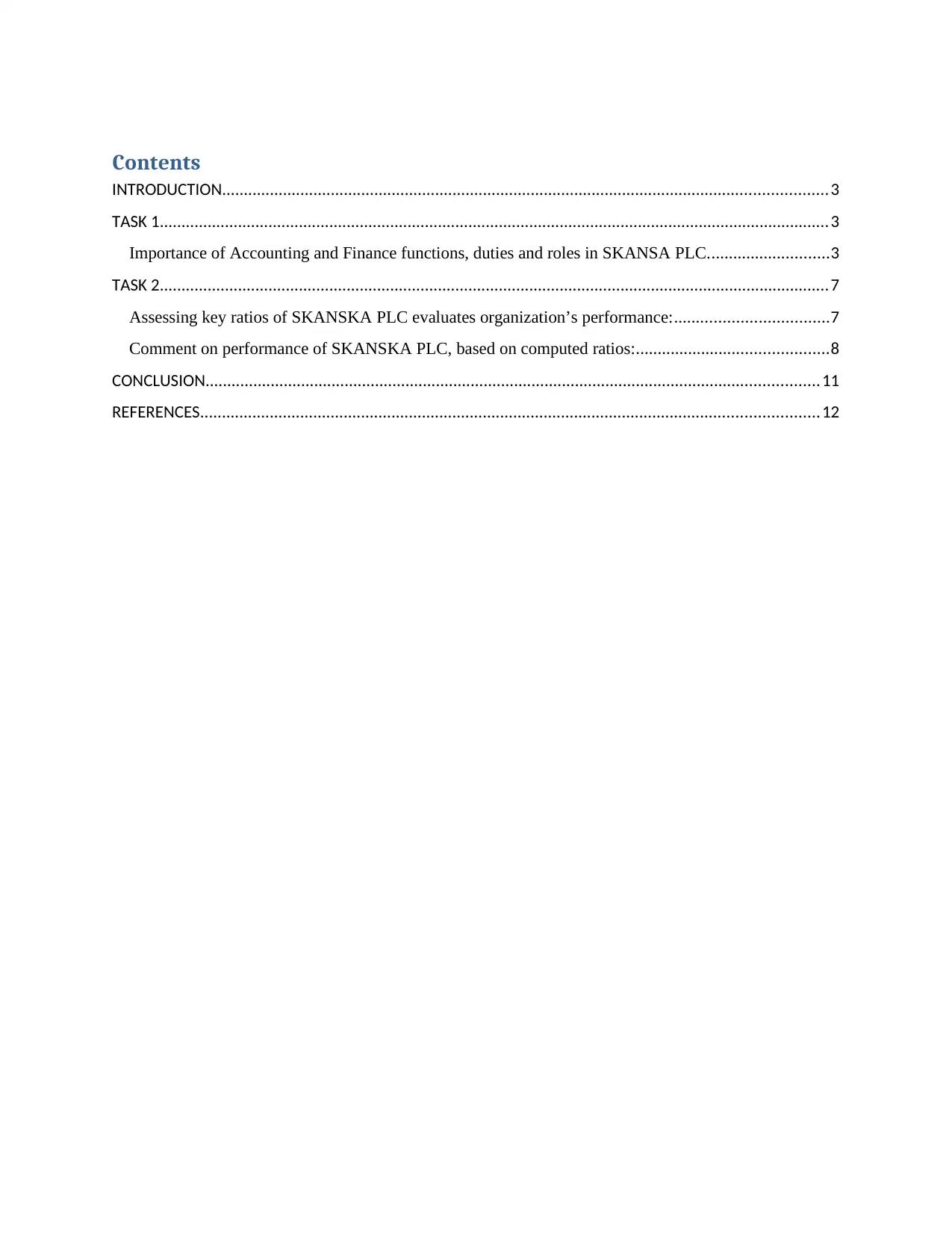
Contents
INTRODUCTION...........................................................................................................................................3
TASK 1..........................................................................................................................................................3
Importance of Accounting and Finance functions, duties and roles in SKANSA PLC............................3
TASK 2..........................................................................................................................................................7
Assessing key ratios of SKANSKA PLC evaluates organization’s performance:...................................7
Comment on performance of SKANSKA PLC, based on computed ratios:............................................8
CONCLUSION.............................................................................................................................................11
REFERENCES..............................................................................................................................................12
INTRODUCTION...........................................................................................................................................3
TASK 1..........................................................................................................................................................3
Importance of Accounting and Finance functions, duties and roles in SKANSA PLC............................3
TASK 2..........................................................................................................................................................7
Assessing key ratios of SKANSKA PLC evaluates organization’s performance:...................................7
Comment on performance of SKANSKA PLC, based on computed ratios:............................................8
CONCLUSION.............................................................................................................................................11
REFERENCES..............................................................................................................................................12
⊘ This is a preview!⊘
Do you want full access?
Subscribe today to unlock all pages.

Trusted by 1+ million students worldwide
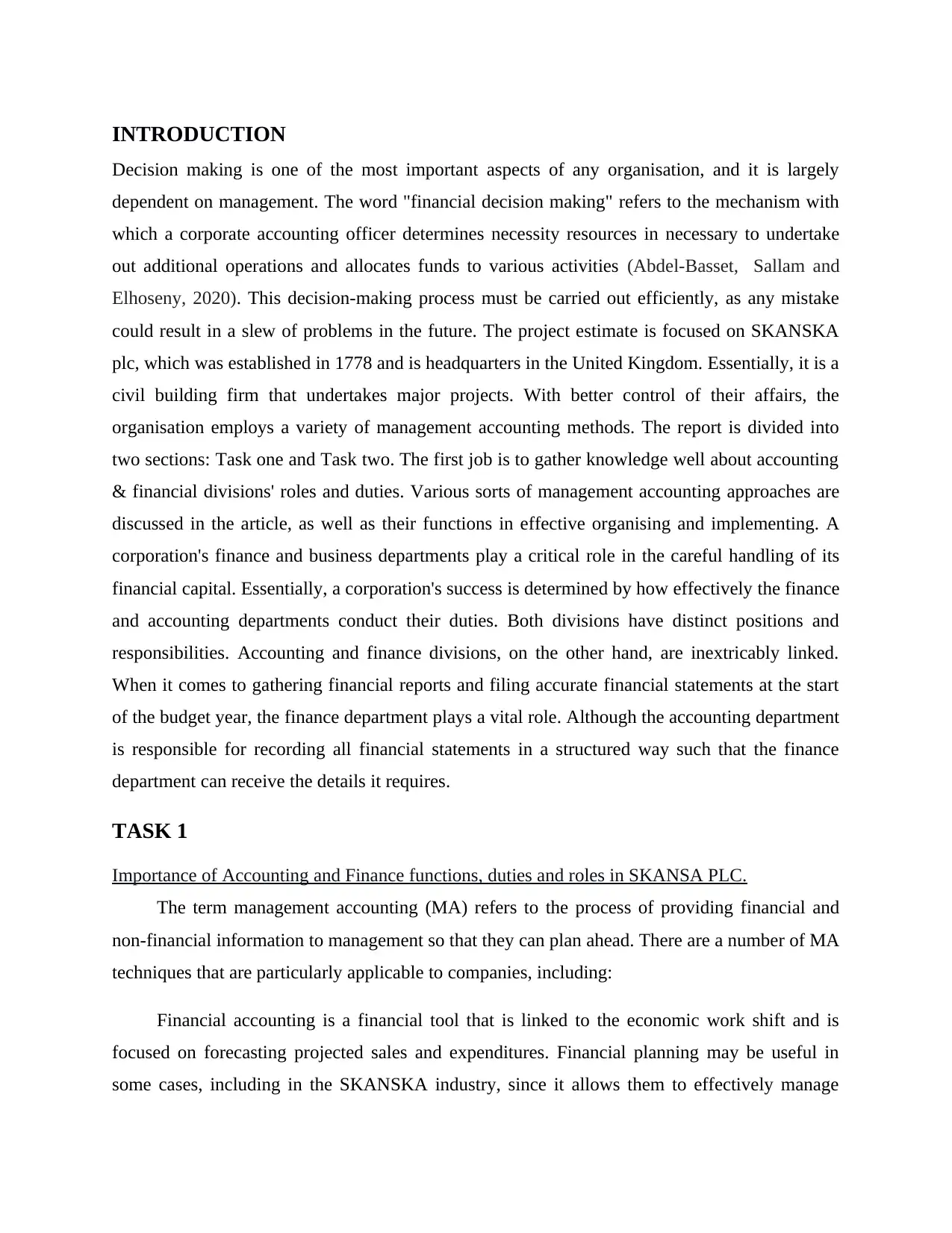
INTRODUCTION
Decision making is one of the most important aspects of any organisation, and it is largely
dependent on management. The word "financial decision making" refers to the mechanism with
which a corporate accounting officer determines necessity resources in necessary to undertake
out additional operations and allocates funds to various activities (Abdel-Basset, Sallam and
Elhoseny, 2020). This decision-making process must be carried out efficiently, as any mistake
could result in a slew of problems in the future. The project estimate is focused on SKANSKA
plc, which was established in 1778 and is headquarters in the United Kingdom. Essentially, it is a
civil building firm that undertakes major projects. With better control of their affairs, the
organisation employs a variety of management accounting methods. The report is divided into
two sections: Task one and Task two. The first job is to gather knowledge well about accounting
& financial divisions' roles and duties. Various sorts of management accounting approaches are
discussed in the article, as well as their functions in effective organising and implementing. A
corporation's finance and business departments play a critical role in the careful handling of its
financial capital. Essentially, a corporation's success is determined by how effectively the finance
and accounting departments conduct their duties. Both divisions have distinct positions and
responsibilities. Accounting and finance divisions, on the other hand, are inextricably linked.
When it comes to gathering financial reports and filing accurate financial statements at the start
of the budget year, the finance department plays a vital role. Although the accounting department
is responsible for recording all financial statements in a structured way such that the finance
department can receive the details it requires.
TASK 1
Importance of Accounting and Finance functions, duties and roles in SKANSA PLC.
The term management accounting (MA) refers to the process of providing financial and
non-financial information to management so that they can plan ahead. There are a number of MA
techniques that are particularly applicable to companies, including:
Financial accounting is a financial tool that is linked to the economic work shift and is
focused on forecasting projected sales and expenditures. Financial planning may be useful in
some cases, including in the SKANSKA industry, since it allows them to effectively manage
Decision making is one of the most important aspects of any organisation, and it is largely
dependent on management. The word "financial decision making" refers to the mechanism with
which a corporate accounting officer determines necessity resources in necessary to undertake
out additional operations and allocates funds to various activities (Abdel-Basset, Sallam and
Elhoseny, 2020). This decision-making process must be carried out efficiently, as any mistake
could result in a slew of problems in the future. The project estimate is focused on SKANSKA
plc, which was established in 1778 and is headquarters in the United Kingdom. Essentially, it is a
civil building firm that undertakes major projects. With better control of their affairs, the
organisation employs a variety of management accounting methods. The report is divided into
two sections: Task one and Task two. The first job is to gather knowledge well about accounting
& financial divisions' roles and duties. Various sorts of management accounting approaches are
discussed in the article, as well as their functions in effective organising and implementing. A
corporation's finance and business departments play a critical role in the careful handling of its
financial capital. Essentially, a corporation's success is determined by how effectively the finance
and accounting departments conduct their duties. Both divisions have distinct positions and
responsibilities. Accounting and finance divisions, on the other hand, are inextricably linked.
When it comes to gathering financial reports and filing accurate financial statements at the start
of the budget year, the finance department plays a vital role. Although the accounting department
is responsible for recording all financial statements in a structured way such that the finance
department can receive the details it requires.
TASK 1
Importance of Accounting and Finance functions, duties and roles in SKANSA PLC.
The term management accounting (MA) refers to the process of providing financial and
non-financial information to management so that they can plan ahead. There are a number of MA
techniques that are particularly applicable to companies, including:
Financial accounting is a financial tool that is linked to the economic work shift and is
focused on forecasting projected sales and expenditures. Financial planning may be useful in
some cases, including in the SKANSKA industry, since it allows them to effectively manage
Paraphrase This Document
Need a fresh take? Get an instant paraphrase of this document with our AI Paraphraser
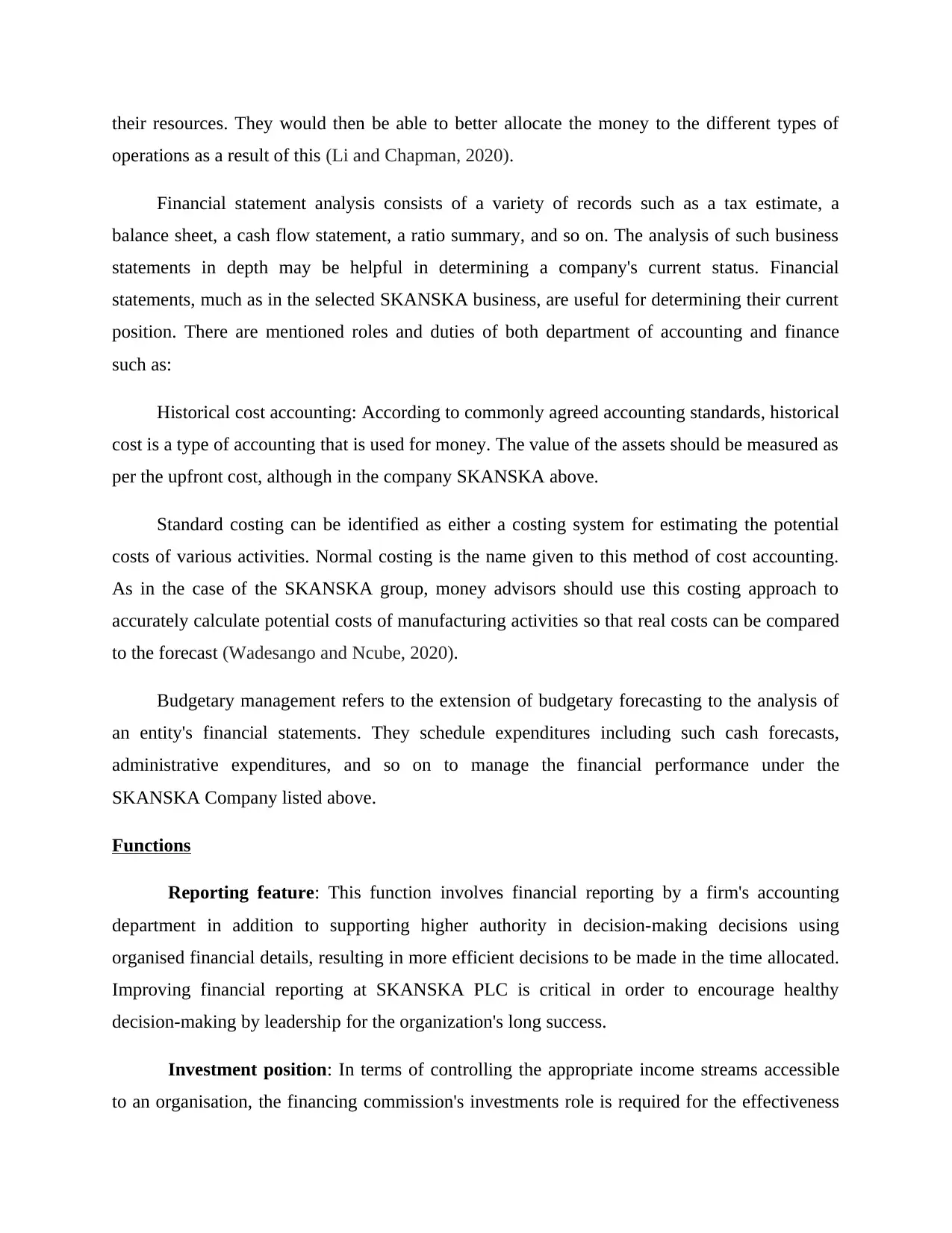
their resources. They would then be able to better allocate the money to the different types of
operations as a result of this (Li and Chapman, 2020).
Financial statement analysis consists of a variety of records such as a tax estimate, a
balance sheet, a cash flow statement, a ratio summary, and so on. The analysis of such business
statements in depth may be helpful in determining a company's current status. Financial
statements, much as in the selected SKANSKA business, are useful for determining their current
position. There are mentioned roles and duties of both department of accounting and finance
such as:
Historical cost accounting: According to commonly agreed accounting standards, historical
cost is a type of accounting that is used for money. The value of the assets should be measured as
per the upfront cost, although in the company SKANSKA above.
Standard costing can be identified as either a costing system for estimating the potential
costs of various activities. Normal costing is the name given to this method of cost accounting.
As in the case of the SKANSKA group, money advisors should use this costing approach to
accurately calculate potential costs of manufacturing activities so that real costs can be compared
to the forecast (Wadesango and Ncube, 2020).
Budgetary management refers to the extension of budgetary forecasting to the analysis of
an entity's financial statements. They schedule expenditures including such cash forecasts,
administrative expenditures, and so on to manage the financial performance under the
SKANSKA Company listed above.
Functions
Reporting feature: This function involves financial reporting by a firm's accounting
department in addition to supporting higher authority in decision-making decisions using
organised financial details, resulting in more efficient decisions to be made in the time allocated.
Improving financial reporting at SKANSKA PLC is critical in order to encourage healthy
decision-making by leadership for the organization's long success.
Investment position: In terms of controlling the appropriate income streams accessible
to an organisation, the financing commission's investments role is required for the effectiveness
operations as a result of this (Li and Chapman, 2020).
Financial statement analysis consists of a variety of records such as a tax estimate, a
balance sheet, a cash flow statement, a ratio summary, and so on. The analysis of such business
statements in depth may be helpful in determining a company's current status. Financial
statements, much as in the selected SKANSKA business, are useful for determining their current
position. There are mentioned roles and duties of both department of accounting and finance
such as:
Historical cost accounting: According to commonly agreed accounting standards, historical
cost is a type of accounting that is used for money. The value of the assets should be measured as
per the upfront cost, although in the company SKANSKA above.
Standard costing can be identified as either a costing system for estimating the potential
costs of various activities. Normal costing is the name given to this method of cost accounting.
As in the case of the SKANSKA group, money advisors should use this costing approach to
accurately calculate potential costs of manufacturing activities so that real costs can be compared
to the forecast (Wadesango and Ncube, 2020).
Budgetary management refers to the extension of budgetary forecasting to the analysis of
an entity's financial statements. They schedule expenditures including such cash forecasts,
administrative expenditures, and so on to manage the financial performance under the
SKANSKA Company listed above.
Functions
Reporting feature: This function involves financial reporting by a firm's accounting
department in addition to supporting higher authority in decision-making decisions using
organised financial details, resulting in more efficient decisions to be made in the time allocated.
Improving financial reporting at SKANSKA PLC is critical in order to encourage healthy
decision-making by leadership for the organization's long success.
Investment position: In terms of controlling the appropriate income streams accessible
to an organisation, the financing commission's investments role is required for the effectiveness
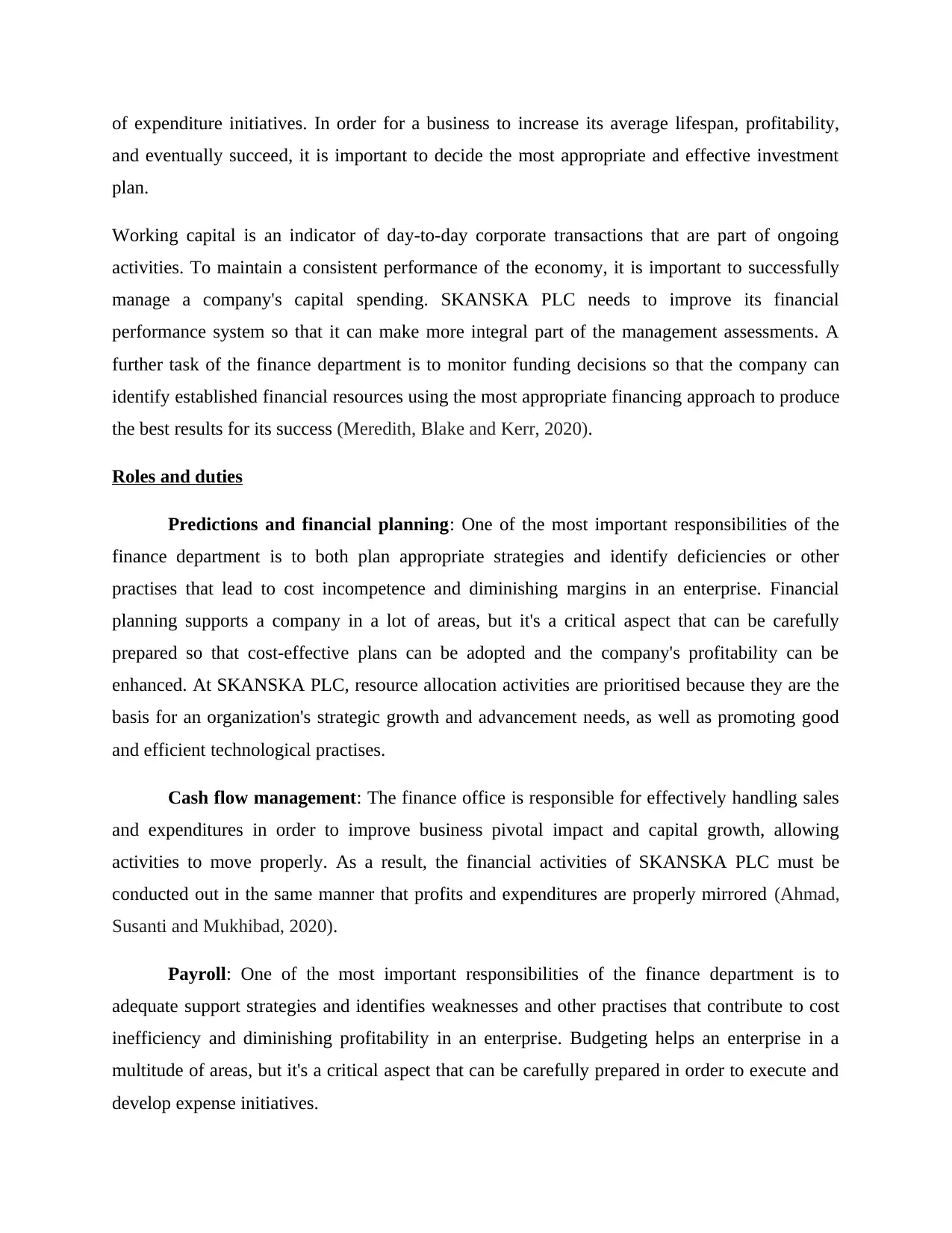
of expenditure initiatives. In order for a business to increase its average lifespan, profitability,
and eventually succeed, it is important to decide the most appropriate and effective investment
plan.
Working capital is an indicator of day-to-day corporate transactions that are part of ongoing
activities. To maintain a consistent performance of the economy, it is important to successfully
manage a company's capital spending. SKANSKA PLC needs to improve its financial
performance system so that it can make more integral part of the management assessments. A
further task of the finance department is to monitor funding decisions so that the company can
identify established financial resources using the most appropriate financing approach to produce
the best results for its success (Meredith, Blake and Kerr, 2020).
Roles and duties
Predictions and financial planning: One of the most important responsibilities of the
finance department is to both plan appropriate strategies and identify deficiencies or other
practises that lead to cost incompetence and diminishing margins in an enterprise. Financial
planning supports a company in a lot of areas, but it's a critical aspect that can be carefully
prepared so that cost-effective plans can be adopted and the company's profitability can be
enhanced. At SKANSKA PLC, resource allocation activities are prioritised because they are the
basis for an organization's strategic growth and advancement needs, as well as promoting good
and efficient technological practises.
Cash flow management: The finance office is responsible for effectively handling sales
and expenditures in order to improve business pivotal impact and capital growth, allowing
activities to move properly. As a result, the financial activities of SKANSKA PLC must be
conducted out in the same manner that profits and expenditures are properly mirrored (Ahmad,
Susanti and Mukhibad, 2020).
Payroll: One of the most important responsibilities of the finance department is to
adequate support strategies and identifies weaknesses and other practises that contribute to cost
inefficiency and diminishing profitability in an enterprise. Budgeting helps an enterprise in a
multitude of areas, but it's a critical aspect that can be carefully prepared in order to execute and
develop expense initiatives.
and eventually succeed, it is important to decide the most appropriate and effective investment
plan.
Working capital is an indicator of day-to-day corporate transactions that are part of ongoing
activities. To maintain a consistent performance of the economy, it is important to successfully
manage a company's capital spending. SKANSKA PLC needs to improve its financial
performance system so that it can make more integral part of the management assessments. A
further task of the finance department is to monitor funding decisions so that the company can
identify established financial resources using the most appropriate financing approach to produce
the best results for its success (Meredith, Blake and Kerr, 2020).
Roles and duties
Predictions and financial planning: One of the most important responsibilities of the
finance department is to both plan appropriate strategies and identify deficiencies or other
practises that lead to cost incompetence and diminishing margins in an enterprise. Financial
planning supports a company in a lot of areas, but it's a critical aspect that can be carefully
prepared so that cost-effective plans can be adopted and the company's profitability can be
enhanced. At SKANSKA PLC, resource allocation activities are prioritised because they are the
basis for an organization's strategic growth and advancement needs, as well as promoting good
and efficient technological practises.
Cash flow management: The finance office is responsible for effectively handling sales
and expenditures in order to improve business pivotal impact and capital growth, allowing
activities to move properly. As a result, the financial activities of SKANSKA PLC must be
conducted out in the same manner that profits and expenditures are properly mirrored (Ahmad,
Susanti and Mukhibad, 2020).
Payroll: One of the most important responsibilities of the finance department is to
adequate support strategies and identifies weaknesses and other practises that contribute to cost
inefficiency and diminishing profitability in an enterprise. Budgeting helps an enterprise in a
multitude of areas, but it's a critical aspect that can be carefully prepared in order to execute and
develop expense initiatives.
⊘ This is a preview!⊘
Do you want full access?
Subscribe today to unlock all pages.

Trusted by 1+ million students worldwide
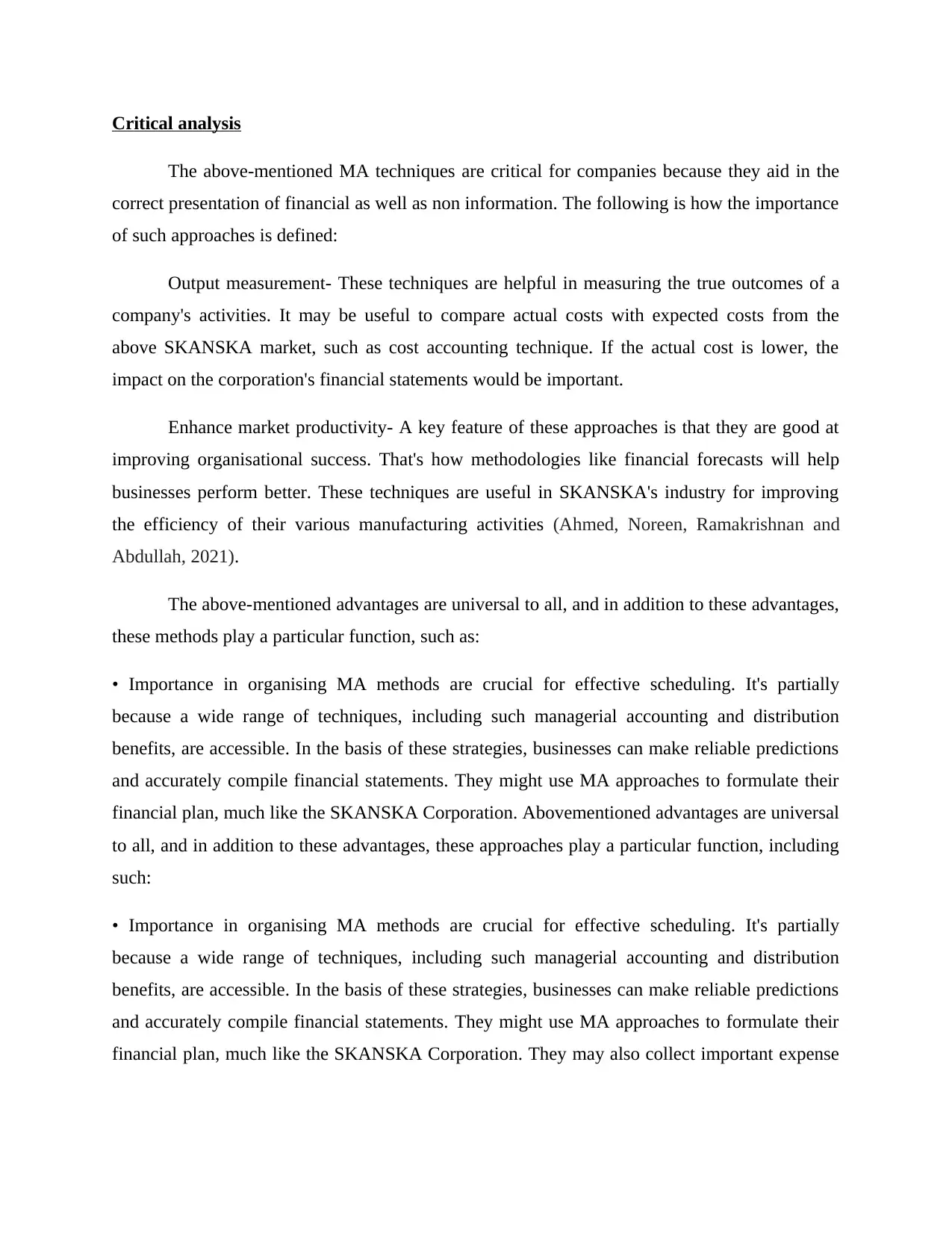
Critical analysis
The above-mentioned MA techniques are critical for companies because they aid in the
correct presentation of financial as well as non information. The following is how the importance
of such approaches is defined:
Output measurement- These techniques are helpful in measuring the true outcomes of a
company's activities. It may be useful to compare actual costs with expected costs from the
above SKANSKA market, such as cost accounting technique. If the actual cost is lower, the
impact on the corporation's financial statements would be important.
Enhance market productivity- A key feature of these approaches is that they are good at
improving organisational success. That's how methodologies like financial forecasts will help
businesses perform better. These techniques are useful in SKANSKA's industry for improving
the efficiency of their various manufacturing activities (Ahmed, Noreen, Ramakrishnan and
Abdullah, 2021).
The above-mentioned advantages are universal to all, and in addition to these advantages,
these methods play a particular function, such as:
• Importance in organising MA methods are crucial for effective scheduling. It's partially
because a wide range of techniques, including such managerial accounting and distribution
benefits, are accessible. In the basis of these strategies, businesses can make reliable predictions
and accurately compile financial statements. They might use MA approaches to formulate their
financial plan, much like the SKANSKA Corporation. Abovementioned advantages are universal
to all, and in addition to these advantages, these approaches play a particular function, including
such:
• Importance in organising MA methods are crucial for effective scheduling. It's partially
because a wide range of techniques, including such managerial accounting and distribution
benefits, are accessible. In the basis of these strategies, businesses can make reliable predictions
and accurately compile financial statements. They might use MA approaches to formulate their
financial plan, much like the SKANSKA Corporation. They may also collect important expense
The above-mentioned MA techniques are critical for companies because they aid in the
correct presentation of financial as well as non information. The following is how the importance
of such approaches is defined:
Output measurement- These techniques are helpful in measuring the true outcomes of a
company's activities. It may be useful to compare actual costs with expected costs from the
above SKANSKA market, such as cost accounting technique. If the actual cost is lower, the
impact on the corporation's financial statements would be important.
Enhance market productivity- A key feature of these approaches is that they are good at
improving organisational success. That's how methodologies like financial forecasts will help
businesses perform better. These techniques are useful in SKANSKA's industry for improving
the efficiency of their various manufacturing activities (Ahmed, Noreen, Ramakrishnan and
Abdullah, 2021).
The above-mentioned advantages are universal to all, and in addition to these advantages,
these methods play a particular function, such as:
• Importance in organising MA methods are crucial for effective scheduling. It's partially
because a wide range of techniques, including such managerial accounting and distribution
benefits, are accessible. In the basis of these strategies, businesses can make reliable predictions
and accurately compile financial statements. They might use MA approaches to formulate their
financial plan, much like the SKANSKA Corporation. Abovementioned advantages are universal
to all, and in addition to these advantages, these approaches play a particular function, including
such:
• Importance in organising MA methods are crucial for effective scheduling. It's partially
because a wide range of techniques, including such managerial accounting and distribution
benefits, are accessible. In the basis of these strategies, businesses can make reliable predictions
and accurately compile financial statements. They might use MA approaches to formulate their
financial plan, much like the SKANSKA Corporation. They may also collect important expense
Paraphrase This Document
Need a fresh take? Get an instant paraphrase of this document with our AI Paraphraser
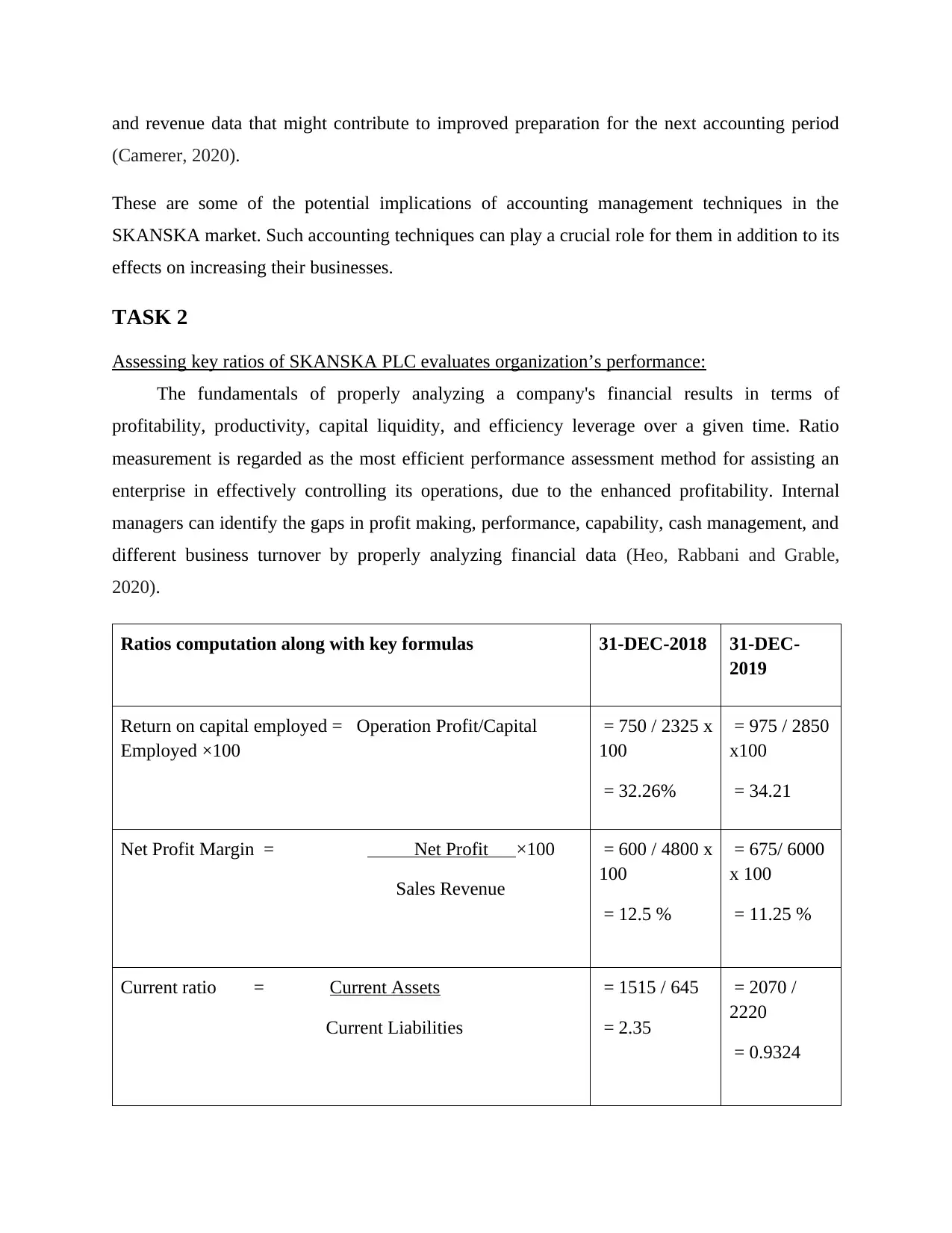
and revenue data that might contribute to improved preparation for the next accounting period
(Camerer, 2020).
These are some of the potential implications of accounting management techniques in the
SKANSKA market. Such accounting techniques can play a crucial role for them in addition to its
effects on increasing their businesses.
TASK 2
Assessing key ratios of SKANSKA PLC evaluates organization’s performance:
The fundamentals of properly analyzing a company's financial results in terms of
profitability, productivity, capital liquidity, and efficiency leverage over a given time. Ratio
measurement is regarded as the most efficient performance assessment method for assisting an
enterprise in effectively controlling its operations, due to the enhanced profitability. Internal
managers can identify the gaps in profit making, performance, capability, cash management, and
different business turnover by properly analyzing financial data (Heo, Rabbani and Grable,
2020).
Ratios computation along with key formulas 31-DEC-2018 31-DEC-
2019
Return on capital employed = Operation Profit/Capital
Employed ×100
= 750 / 2325 x
100
= 32.26%
= 975 / 2850
x100
= 34.21
Net Profit Margin = Net Profit ×100
Sales Revenue
= 600 / 4800 x
100
= 12.5 %
= 675/ 6000
x 100
= 11.25 %
Current ratio = Current Assets
Current Liabilities
= 1515 / 645
= 2.35
= 2070 /
2220
= 0.9324
(Camerer, 2020).
These are some of the potential implications of accounting management techniques in the
SKANSKA market. Such accounting techniques can play a crucial role for them in addition to its
effects on increasing their businesses.
TASK 2
Assessing key ratios of SKANSKA PLC evaluates organization’s performance:
The fundamentals of properly analyzing a company's financial results in terms of
profitability, productivity, capital liquidity, and efficiency leverage over a given time. Ratio
measurement is regarded as the most efficient performance assessment method for assisting an
enterprise in effectively controlling its operations, due to the enhanced profitability. Internal
managers can identify the gaps in profit making, performance, capability, cash management, and
different business turnover by properly analyzing financial data (Heo, Rabbani and Grable,
2020).
Ratios computation along with key formulas 31-DEC-2018 31-DEC-
2019
Return on capital employed = Operation Profit/Capital
Employed ×100
= 750 / 2325 x
100
= 32.26%
= 975 / 2850
x100
= 34.21
Net Profit Margin = Net Profit ×100
Sales Revenue
= 600 / 4800 x
100
= 12.5 %
= 675/ 6000
x 100
= 11.25 %
Current ratio = Current Assets
Current Liabilities
= 1515 / 645
= 2.35
= 2070 /
2220
= 0.9324
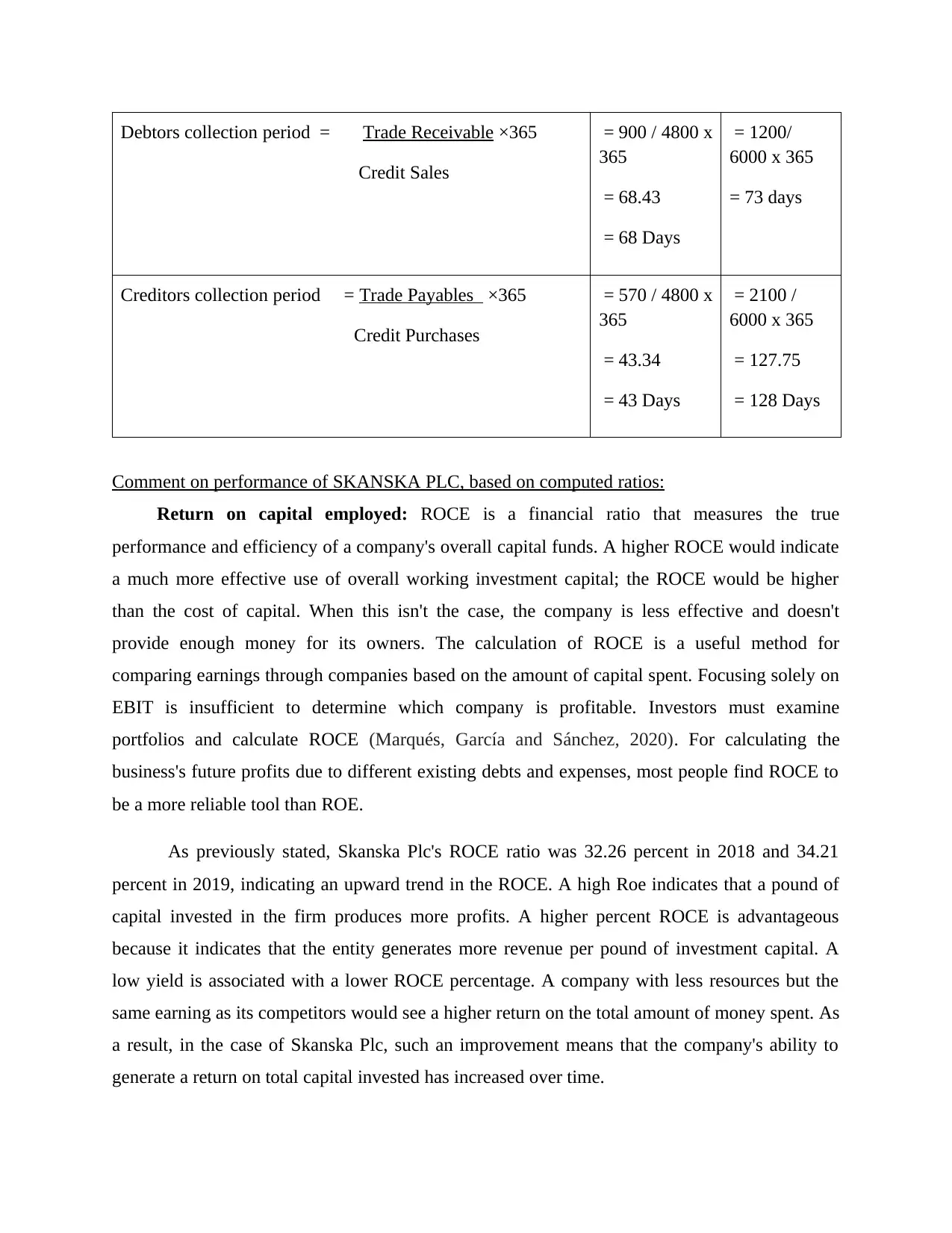
Debtors collection period = Trade Receivable ×365
Credit Sales
= 900 / 4800 x
365
= 68.43
= 68 Days
= 1200/
6000 x 365
= 73 days
Creditors collection period = Trade Payables ×365
Credit Purchases
= 570 / 4800 x
365
= 43.34
= 43 Days
= 2100 /
6000 x 365
= 127.75
= 128 Days
Comment on performance of SKANSKA PLC, based on computed ratios:
Return on capital employed: ROCE is a financial ratio that measures the true
performance and efficiency of a company's overall capital funds. A higher ROCE would indicate
a much more effective use of overall working investment capital; the ROCE would be higher
than the cost of capital. When this isn't the case, the company is less effective and doesn't
provide enough money for its owners. The calculation of ROCE is a useful method for
comparing earnings through companies based on the amount of capital spent. Focusing solely on
EBIT is insufficient to determine which company is profitable. Investors must examine
portfolios and calculate ROCE (Marqués, García and Sánchez, 2020). For calculating the
business's future profits due to different existing debts and expenses, most people find ROCE to
be a more reliable tool than ROE.
As previously stated, Skanska Plc's ROCE ratio was 32.26 percent in 2018 and 34.21
percent in 2019, indicating an upward trend in the ROCE. A high Roe indicates that a pound of
capital invested in the firm produces more profits. A higher percent ROCE is advantageous
because it indicates that the entity generates more revenue per pound of investment capital. A
low yield is associated with a lower ROCE percentage. A company with less resources but the
same earning as its competitors would see a higher return on the total amount of money spent. As
a result, in the case of Skanska Plc, such an improvement means that the company's ability to
generate a return on total capital invested has increased over time.
Credit Sales
= 900 / 4800 x
365
= 68.43
= 68 Days
= 1200/
6000 x 365
= 73 days
Creditors collection period = Trade Payables ×365
Credit Purchases
= 570 / 4800 x
365
= 43.34
= 43 Days
= 2100 /
6000 x 365
= 127.75
= 128 Days
Comment on performance of SKANSKA PLC, based on computed ratios:
Return on capital employed: ROCE is a financial ratio that measures the true
performance and efficiency of a company's overall capital funds. A higher ROCE would indicate
a much more effective use of overall working investment capital; the ROCE would be higher
than the cost of capital. When this isn't the case, the company is less effective and doesn't
provide enough money for its owners. The calculation of ROCE is a useful method for
comparing earnings through companies based on the amount of capital spent. Focusing solely on
EBIT is insufficient to determine which company is profitable. Investors must examine
portfolios and calculate ROCE (Marqués, García and Sánchez, 2020). For calculating the
business's future profits due to different existing debts and expenses, most people find ROCE to
be a more reliable tool than ROE.
As previously stated, Skanska Plc's ROCE ratio was 32.26 percent in 2018 and 34.21
percent in 2019, indicating an upward trend in the ROCE. A high Roe indicates that a pound of
capital invested in the firm produces more profits. A higher percent ROCE is advantageous
because it indicates that the entity generates more revenue per pound of investment capital. A
low yield is associated with a lower ROCE percentage. A company with less resources but the
same earning as its competitors would see a higher return on the total amount of money spent. As
a result, in the case of Skanska Plc, such an improvement means that the company's ability to
generate a return on total capital invested has increased over time.
⊘ This is a preview!⊘
Do you want full access?
Subscribe today to unlock all pages.

Trusted by 1+ million students worldwide
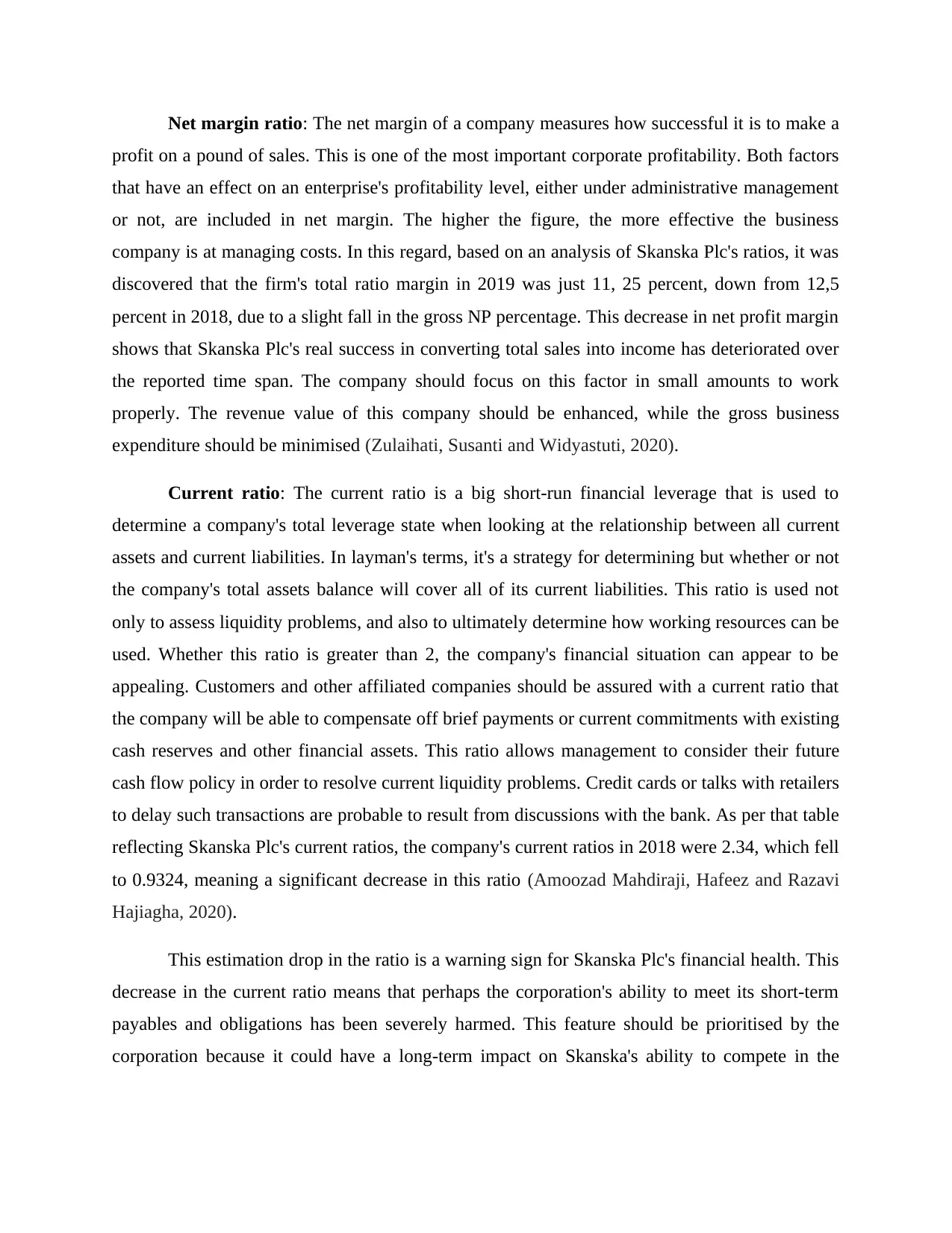
Net margin ratio: The net margin of a company measures how successful it is to make a
profit on a pound of sales. This is one of the most important corporate profitability. Both factors
that have an effect on an enterprise's profitability level, either under administrative management
or not, are included in net margin. The higher the figure, the more effective the business
company is at managing costs. In this regard, based on an analysis of Skanska Plc's ratios, it was
discovered that the firm's total ratio margin in 2019 was just 11, 25 percent, down from 12,5
percent in 2018, due to a slight fall in the gross NP percentage. This decrease in net profit margin
shows that Skanska Plc's real success in converting total sales into income has deteriorated over
the reported time span. The company should focus on this factor in small amounts to work
properly. The revenue value of this company should be enhanced, while the gross business
expenditure should be minimised (Zulaihati, Susanti and Widyastuti, 2020).
Current ratio: The current ratio is a big short-run financial leverage that is used to
determine a company's total leverage state when looking at the relationship between all current
assets and current liabilities. In layman's terms, it's a strategy for determining but whether or not
the company's total assets balance will cover all of its current liabilities. This ratio is used not
only to assess liquidity problems, and also to ultimately determine how working resources can be
used. Whether this ratio is greater than 2, the company's financial situation can appear to be
appealing. Customers and other affiliated companies should be assured with a current ratio that
the company will be able to compensate off brief payments or current commitments with existing
cash reserves and other financial assets. This ratio allows management to consider their future
cash flow policy in order to resolve current liquidity problems. Credit cards or talks with retailers
to delay such transactions are probable to result from discussions with the bank. As per that table
reflecting Skanska Plc's current ratios, the company's current ratios in 2018 were 2.34, which fell
to 0.9324, meaning a significant decrease in this ratio (Amoozad Mahdiraji, Hafeez and Razavi
Hajiagha, 2020).
This estimation drop in the ratio is a warning sign for Skanska Plc's financial health. This
decrease in the current ratio means that perhaps the corporation's ability to meet its short-term
payables and obligations has been severely harmed. This feature should be prioritised by the
corporation because it could have a long-term impact on Skanska's ability to compete in the
profit on a pound of sales. This is one of the most important corporate profitability. Both factors
that have an effect on an enterprise's profitability level, either under administrative management
or not, are included in net margin. The higher the figure, the more effective the business
company is at managing costs. In this regard, based on an analysis of Skanska Plc's ratios, it was
discovered that the firm's total ratio margin in 2019 was just 11, 25 percent, down from 12,5
percent in 2018, due to a slight fall in the gross NP percentage. This decrease in net profit margin
shows that Skanska Plc's real success in converting total sales into income has deteriorated over
the reported time span. The company should focus on this factor in small amounts to work
properly. The revenue value of this company should be enhanced, while the gross business
expenditure should be minimised (Zulaihati, Susanti and Widyastuti, 2020).
Current ratio: The current ratio is a big short-run financial leverage that is used to
determine a company's total leverage state when looking at the relationship between all current
assets and current liabilities. In layman's terms, it's a strategy for determining but whether or not
the company's total assets balance will cover all of its current liabilities. This ratio is used not
only to assess liquidity problems, and also to ultimately determine how working resources can be
used. Whether this ratio is greater than 2, the company's financial situation can appear to be
appealing. Customers and other affiliated companies should be assured with a current ratio that
the company will be able to compensate off brief payments or current commitments with existing
cash reserves and other financial assets. This ratio allows management to consider their future
cash flow policy in order to resolve current liquidity problems. Credit cards or talks with retailers
to delay such transactions are probable to result from discussions with the bank. As per that table
reflecting Skanska Plc's current ratios, the company's current ratios in 2018 were 2.34, which fell
to 0.9324, meaning a significant decrease in this ratio (Amoozad Mahdiraji, Hafeez and Razavi
Hajiagha, 2020).
This estimation drop in the ratio is a warning sign for Skanska Plc's financial health. This
decrease in the current ratio means that perhaps the corporation's ability to meet its short-term
payables and obligations has been severely harmed. This feature should be prioritised by the
corporation because it could have a long-term impact on Skanska's ability to compete in the
Paraphrase This Document
Need a fresh take? Get an instant paraphrase of this document with our AI Paraphraser
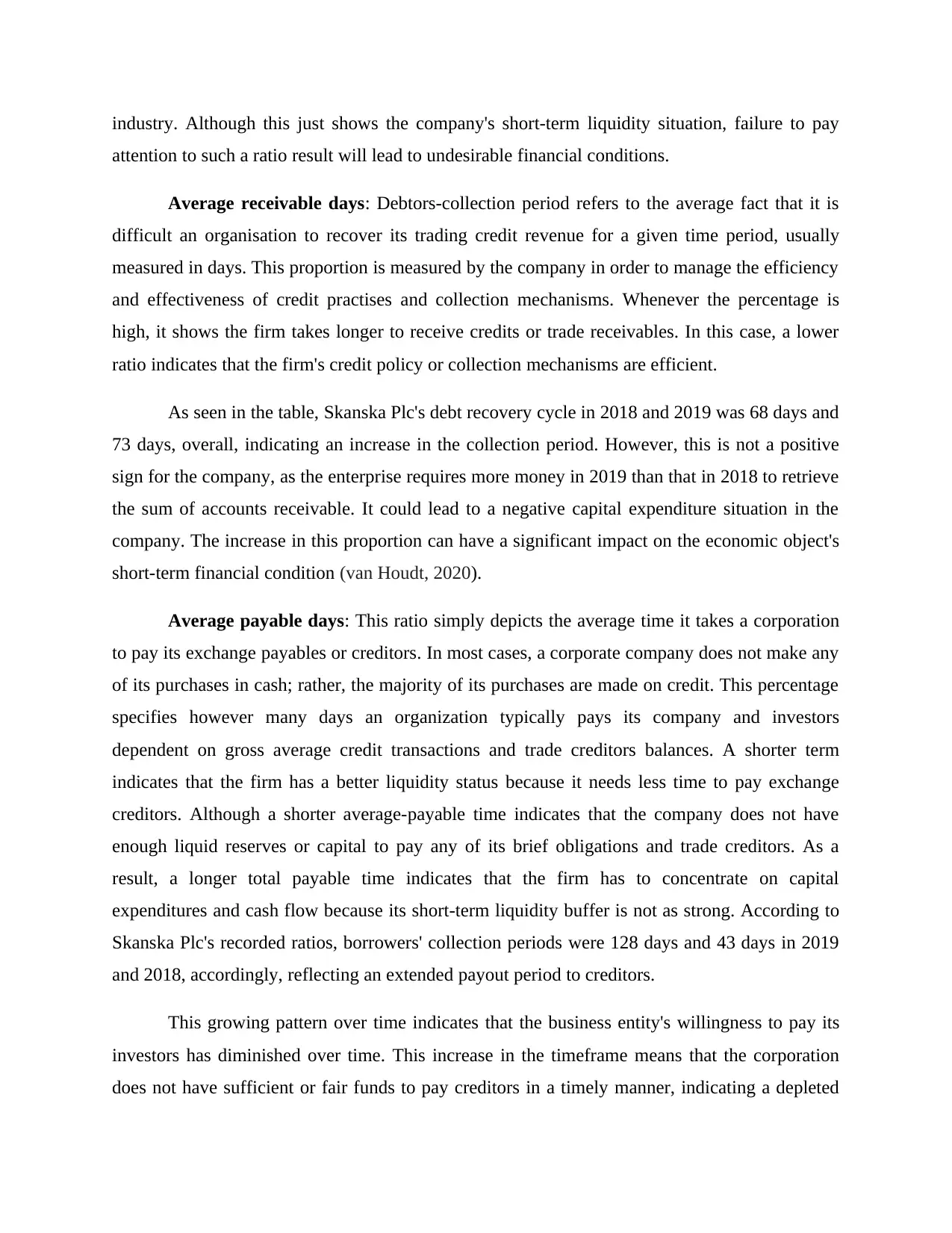
industry. Although this just shows the company's short-term liquidity situation, failure to pay
attention to such a ratio result will lead to undesirable financial conditions.
Average receivable days: Debtors-collection period refers to the average fact that it is
difficult an organisation to recover its trading credit revenue for a given time period, usually
measured in days. This proportion is measured by the company in order to manage the efficiency
and effectiveness of credit practises and collection mechanisms. Whenever the percentage is
high, it shows the firm takes longer to receive credits or trade receivables. In this case, a lower
ratio indicates that the firm's credit policy or collection mechanisms are efficient.
As seen in the table, Skanska Plc's debt recovery cycle in 2018 and 2019 was 68 days and
73 days, overall, indicating an increase in the collection period. However, this is not a positive
sign for the company, as the enterprise requires more money in 2019 than that in 2018 to retrieve
the sum of accounts receivable. It could lead to a negative capital expenditure situation in the
company. The increase in this proportion can have a significant impact on the economic object's
short-term financial condition (van Houdt, 2020).
Average payable days: This ratio simply depicts the average time it takes a corporation
to pay its exchange payables or creditors. In most cases, a corporate company does not make any
of its purchases in cash; rather, the majority of its purchases are made on credit. This percentage
specifies however many days an organization typically pays its company and investors
dependent on gross average credit transactions and trade creditors balances. A shorter term
indicates that the firm has a better liquidity status because it needs less time to pay exchange
creditors. Although a shorter average-payable time indicates that the company does not have
enough liquid reserves or capital to pay any of its brief obligations and trade creditors. As a
result, a longer total payable time indicates that the firm has to concentrate on capital
expenditures and cash flow because its short-term liquidity buffer is not as strong. According to
Skanska Plc's recorded ratios, borrowers' collection periods were 128 days and 43 days in 2019
and 2018, accordingly, reflecting an extended payout period to creditors.
This growing pattern over time indicates that the business entity's willingness to pay its
investors has diminished over time. This increase in the timeframe means that the corporation
does not have sufficient or fair funds to pay creditors in a timely manner, indicating a depleted
attention to such a ratio result will lead to undesirable financial conditions.
Average receivable days: Debtors-collection period refers to the average fact that it is
difficult an organisation to recover its trading credit revenue for a given time period, usually
measured in days. This proportion is measured by the company in order to manage the efficiency
and effectiveness of credit practises and collection mechanisms. Whenever the percentage is
high, it shows the firm takes longer to receive credits or trade receivables. In this case, a lower
ratio indicates that the firm's credit policy or collection mechanisms are efficient.
As seen in the table, Skanska Plc's debt recovery cycle in 2018 and 2019 was 68 days and
73 days, overall, indicating an increase in the collection period. However, this is not a positive
sign for the company, as the enterprise requires more money in 2019 than that in 2018 to retrieve
the sum of accounts receivable. It could lead to a negative capital expenditure situation in the
company. The increase in this proportion can have a significant impact on the economic object's
short-term financial condition (van Houdt, 2020).
Average payable days: This ratio simply depicts the average time it takes a corporation
to pay its exchange payables or creditors. In most cases, a corporate company does not make any
of its purchases in cash; rather, the majority of its purchases are made on credit. This percentage
specifies however many days an organization typically pays its company and investors
dependent on gross average credit transactions and trade creditors balances. A shorter term
indicates that the firm has a better liquidity status because it needs less time to pay exchange
creditors. Although a shorter average-payable time indicates that the company does not have
enough liquid reserves or capital to pay any of its brief obligations and trade creditors. As a
result, a longer total payable time indicates that the firm has to concentrate on capital
expenditures and cash flow because its short-term liquidity buffer is not as strong. According to
Skanska Plc's recorded ratios, borrowers' collection periods were 128 days and 43 days in 2019
and 2018, accordingly, reflecting an extended payout period to creditors.
This growing pattern over time indicates that the business entity's willingness to pay its
investors has diminished over time. This increase in the timeframe means that the corporation
does not have sufficient or fair funds to pay creditors in a timely manner, indicating a depleted
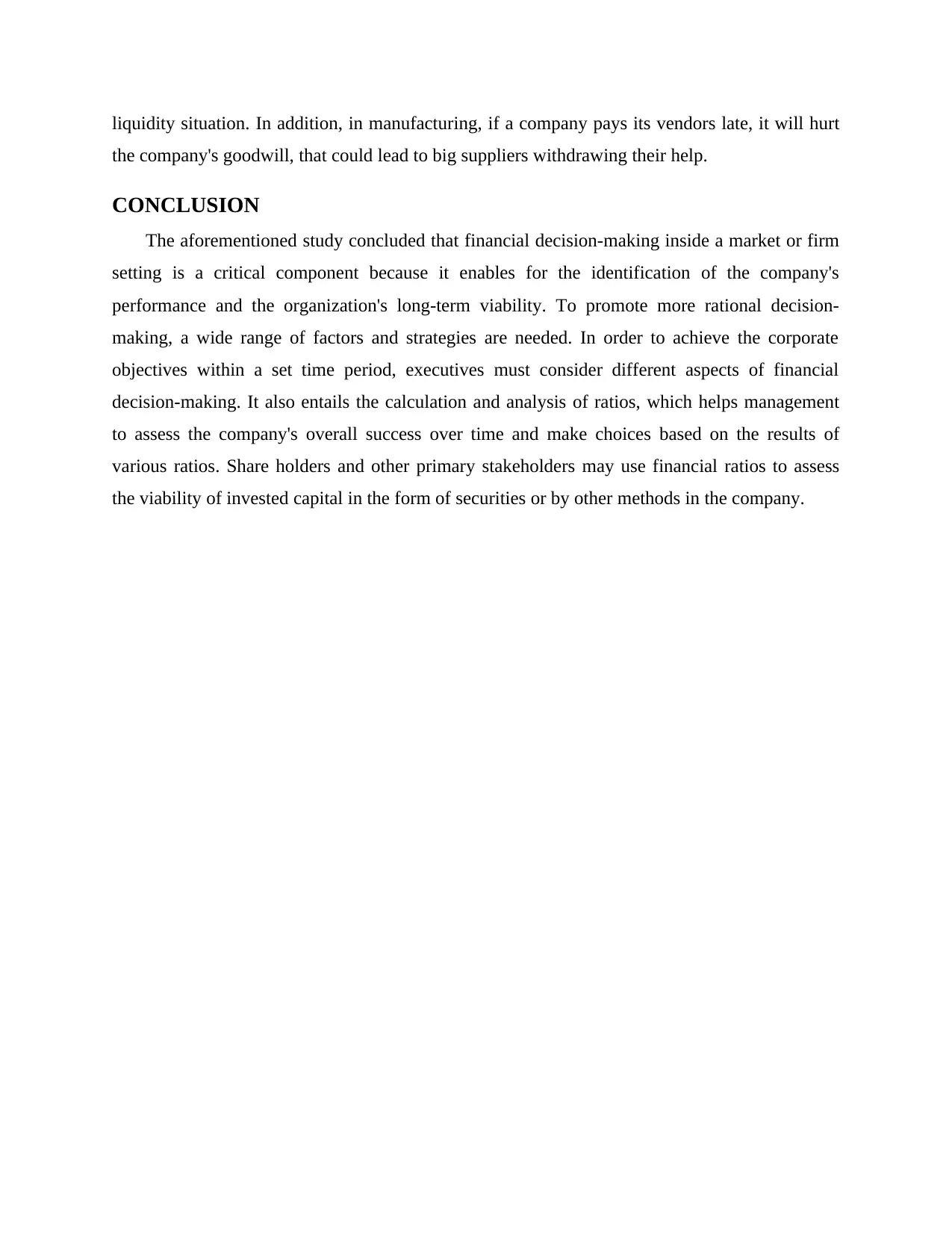
liquidity situation. In addition, in manufacturing, if a company pays its vendors late, it will hurt
the company's goodwill, that could lead to big suppliers withdrawing their help.
CONCLUSION
The aforementioned study concluded that financial decision-making inside a market or firm
setting is a critical component because it enables for the identification of the company's
performance and the organization's long-term viability. To promote more rational decision-
making, a wide range of factors and strategies are needed. In order to achieve the corporate
objectives within a set time period, executives must consider different aspects of financial
decision-making. It also entails the calculation and analysis of ratios, which helps management
to assess the company's overall success over time and make choices based on the results of
various ratios. Share holders and other primary stakeholders may use financial ratios to assess
the viability of invested capital in the form of securities or by other methods in the company.
the company's goodwill, that could lead to big suppliers withdrawing their help.
CONCLUSION
The aforementioned study concluded that financial decision-making inside a market or firm
setting is a critical component because it enables for the identification of the company's
performance and the organization's long-term viability. To promote more rational decision-
making, a wide range of factors and strategies are needed. In order to achieve the corporate
objectives within a set time period, executives must consider different aspects of financial
decision-making. It also entails the calculation and analysis of ratios, which helps management
to assess the company's overall success over time and make choices based on the results of
various ratios. Share holders and other primary stakeholders may use financial ratios to assess
the viability of invested capital in the form of securities or by other methods in the company.
⊘ This is a preview!⊘
Do you want full access?
Subscribe today to unlock all pages.

Trusted by 1+ million students worldwide
1 out of 14
Related Documents
Your All-in-One AI-Powered Toolkit for Academic Success.
+13062052269
info@desklib.com
Available 24*7 on WhatsApp / Email
![[object Object]](/_next/static/media/star-bottom.7253800d.svg)
Unlock your academic potential
Copyright © 2020–2025 A2Z Services. All Rights Reserved. Developed and managed by ZUCOL.





